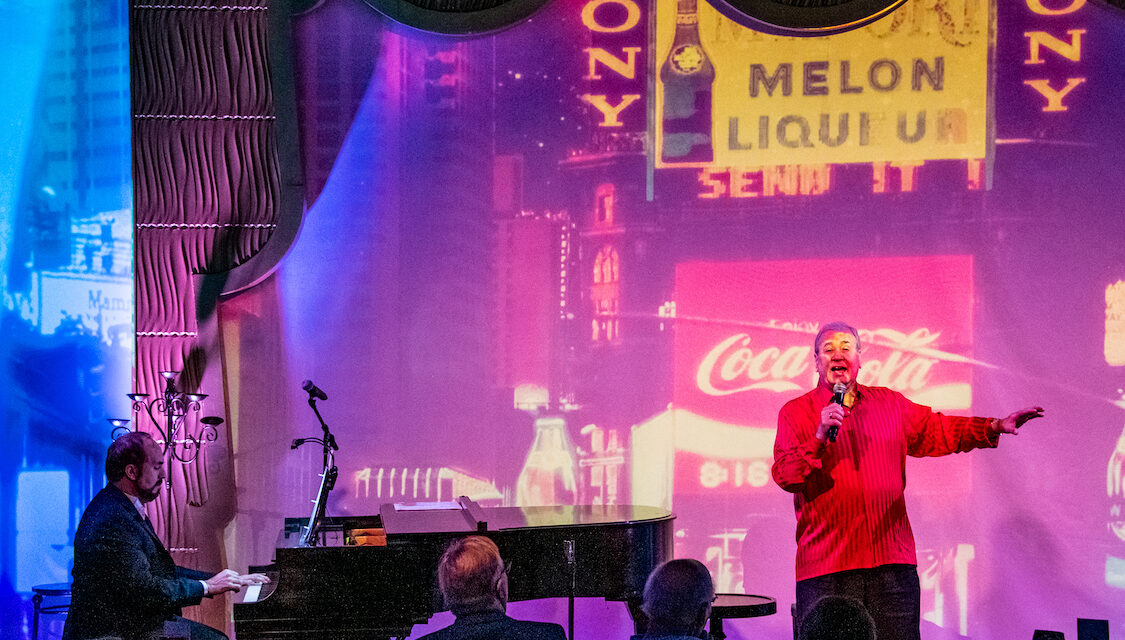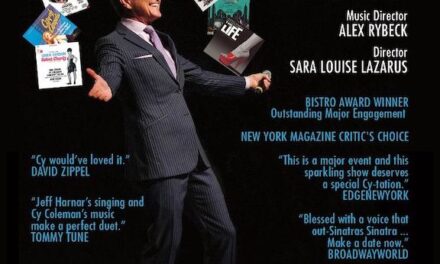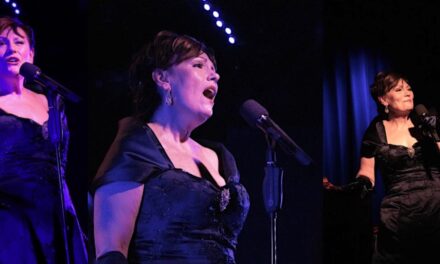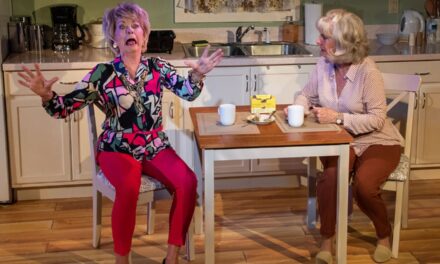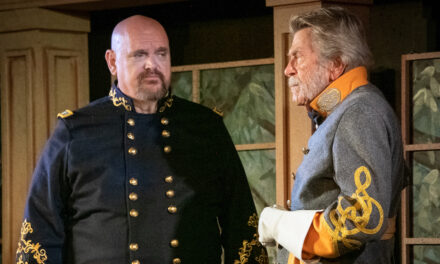Review by Myra Chanin . . . .
I spent Saturday afternoon sampling the fruits of the spectacular interaction between a quartet of indefatigable theatrical somebodies. Let’s start with three tenacious female entrepreneurs, aka Team Wick.
There’s Marilynn A., aka Mom, who began life as a small-town farm girl in Sugar Grove, PA—which reminds old-timers like me of the tag that launched every 15-minute episode of Our Gal Sunday, broadcast at 12:45 pm from Monday to Friday, 1934-1959, on the CBS radio network: Can a girl from a small mining town in Western Pennsylvania (sic) find happiness as the wife of a wealthy and titled Englishman, Lord Henry Brinthrop? I believe neither Marilyn nor Sunday did.

After her divorce, Marilynn moved to Florida so her daughters could live near their father. While she dabbled in real estate, she noticed the scarcity of window washers available to clean the glass panes in the increasing number of high-rise buildings springing up in the area. The firm she founded very successfully filled that void. Her next Eureka business insight occurred when her daughters, Kimberly and Kelly, created a Santa Claus suit on the kitchen table to rent out during the holidays for extra money. The response to their one-line local newspaper ad had Marilyn’s phone ringing non-stop and made her aware of how everybody loved dressing up. Her little costume store became Costume World, which now includes the largest collection of actual Broadway musical costumes and led to her purchase of the Wick Theater. She’s now the Executive Founding and Managing Director of both.
That brings us to the Gala Opening of an immersible event called Dancing Feet, The Experience, conceived and created by daughter Kimberly Wick, Costume Museum Club curator for which daughter Kelly Wick handles marketing. Kelly may even have supernatural powers. Whenever Marilyn is tempted but worried about stepping out in a new direction, Kelly’s voice is the one that urges her to “just do it” and assures her everything will turn out fine. So far Kelly has always been right!


The Gala opened with a luncheon, an amuse bouche butter lettuce salad, and a choice of three delicate but filling lunch choices: Lobster Tail Francoise in White Wine Lemon Butter Sauce; Roasted Marinated Beef Tenderloin in Bearnaise Sauce, both accompanied by Roasted Potato Lasagna and a medley of crisp Baby Vegetables; and for vegetarians, Black Truffled Butternut Squash Risotto in a crisp Parmesan Basket. How good were the viands? Everybody at my table made them all disappear. As for the Triple Chocolate Espresso Brownie waiting to be served at the performance’s end, it was either gobbled right up or boxed to be carried home and gobbled up with no one looking.
Dancing Feet, The Experience, began with Josieu Jean and Kacey Koploff‘s exciting projections of the 1980 Tony Award Winning, Gower Champion choreographed and directed embodiment of the four most delightful words in the English language: musical comedy and 42nd Street. The projections included amazing dancing by the fourth member of the above-mentioned quartet, Lee Roy Reams, who played Billy Lawlor, the original romantic dancing lead. His terpsichorean legerdemain made Fred Astaire and Gene Kelly look like dropouts from a mob-protected dance arts academy in a South Philadelphia basement. Lee Roy Reams, correctly hailed by the NY Times as Broadway’s nonpareil song and dance man was the youngest in a brood of seven, described by their mother as “three girls, three boys and Lee Roy.” He was considered extremely gifted by his teacher who quickly moved him into an advanced class and told him something she’d never told any other student: that he could make a living singing and dancing. As a college senior he choreographed and directed plays, then arrived in New York as a seasoned performer with an Equity card. At first fearful that the interest in him displayed by a casting director might be sexual, Lee Roy was relieved after dining with him because “gay men don’t eat like that.”


He was being considered for the rather minor role of Andy Lee in 42nd Street and was thinking of not showing up for the auditions until a friend told him to just do the routines he’d practiced when he was hoping to get the dancing lead. When he was finished, Gower Champion pulled him aside and admitted that Lee Roy was just not the right guy to be Andy Lee, but that he was perfect for the dancing lead, Billy Lawler. He was even given an additional solo number, “We’re in the Money,” after he replied, “Yes!” when Gower asked, “Do you think you could tap dance on a dime?”
When the emersion presentation ended, we were immersed in Lee Roy Reams, who hopped on stage smiling in a red satin shirt, a big smile and fit as a fiddle—and who then sang three 42nd Street hits accompanied on the piano by the accomplished Michael Ursua who had been the conductor and pianist of the band for the Wick Theater’s sensational opener, I Love a Piano. Lee Roy spoke about his Carbonell award for being the first man to play Dolly at the Wick and also spoke about his friendships with show business icons like Ruby Keeler—Al Jolson’s third wife—who starred in the original 1933 42nd Street film. After she was long retired, he asked her at a dinner whether she could appear in a show with him. She said she couldn’t, because over the years she’d given away every pair of her dancing shoes . . . to be auctioned off for various charitable causes. Lee Roy called the former supplier of her tap shoes, who still had her dimensions, and ordered a pair for her. When he gave them to her she was very touched and cried as Lee Roy assured her, “As long as I’m alive you’re never gonna be without shoes.”


He was also friendly with Jerry Orbach, who co-starred with him in 42nd Street, describing him as a 9-to-5 actor who arrived timely, played scrabble till it was almost time to go on—when he’d put on some make-up and do his thing—and always departed right after the curtain calls. When Lee Roy asked him why he never went out with the cast, Jerry said that he had a red-hot wife and a very cold drink waiting for him and was always ready to go home. When Orbach, not a strong singer, was asked to sing the national anthem at a baseball game, he took Lee Roy along, hoping to get Lee Roy to sing instead. Lee Roy agreed, but flubbed the final lines, proclaiming the US as “the land of the sea and home of the brave.”
Gower Champion, the choreographer/director of 42nd Street was an old-fashioned song-and-dance man, rather than a hoofer, so Lee Roy and the two dance assistants co-created most of the tap routines in the show. Champion wasn’t well, but not until the last week of the show’s Washington tryouts did he learn he had a rare form of blood cancer. On opening night, after curtain calls, David Merrick informed the cast and the audience that Gower Champion had died that afternoon. Champion had told Lee Roy that he’d taken on the show because he didn’t want to be remembered as a has-been.


Lee Roy spoke about directing the last revival of Hello Dolly with Carol Channing and his Evening with Jerry Herman and his concert and cabaret appearances, which have taken him around the world as well as into the White House, where he entertained Presidents Carter, Reagan, Bush Sr. and Clinton.
Lee Roy ended the afternoon answering questions from members of an elite audience who asked about things they wanted to know rather than pretentious queries showing off how knowledgeable they were.
For future immersive performances of Dancing Feet, alas sans Lee Roy Reams in the flesh, but still on tape, call the Wick Theater Box Office at 561-995-2333. www.thewick.org
Photos: Amy Paquantonio


